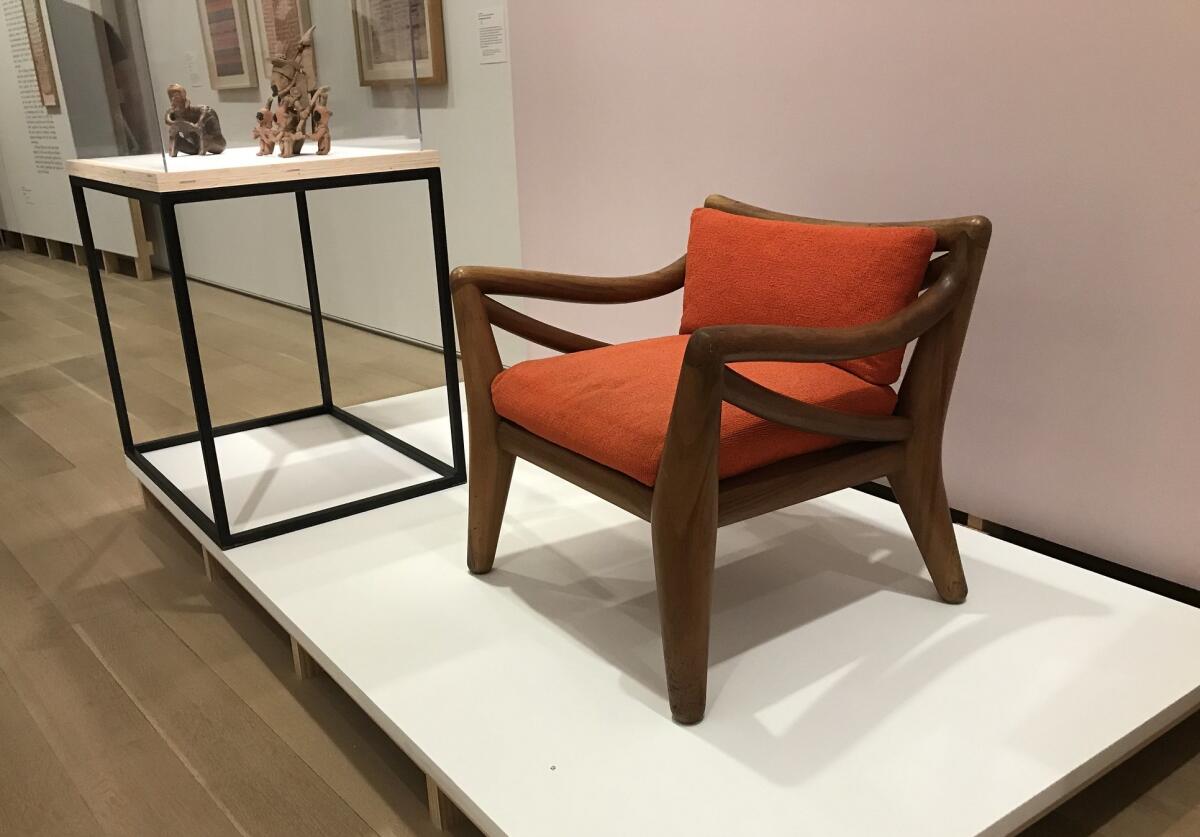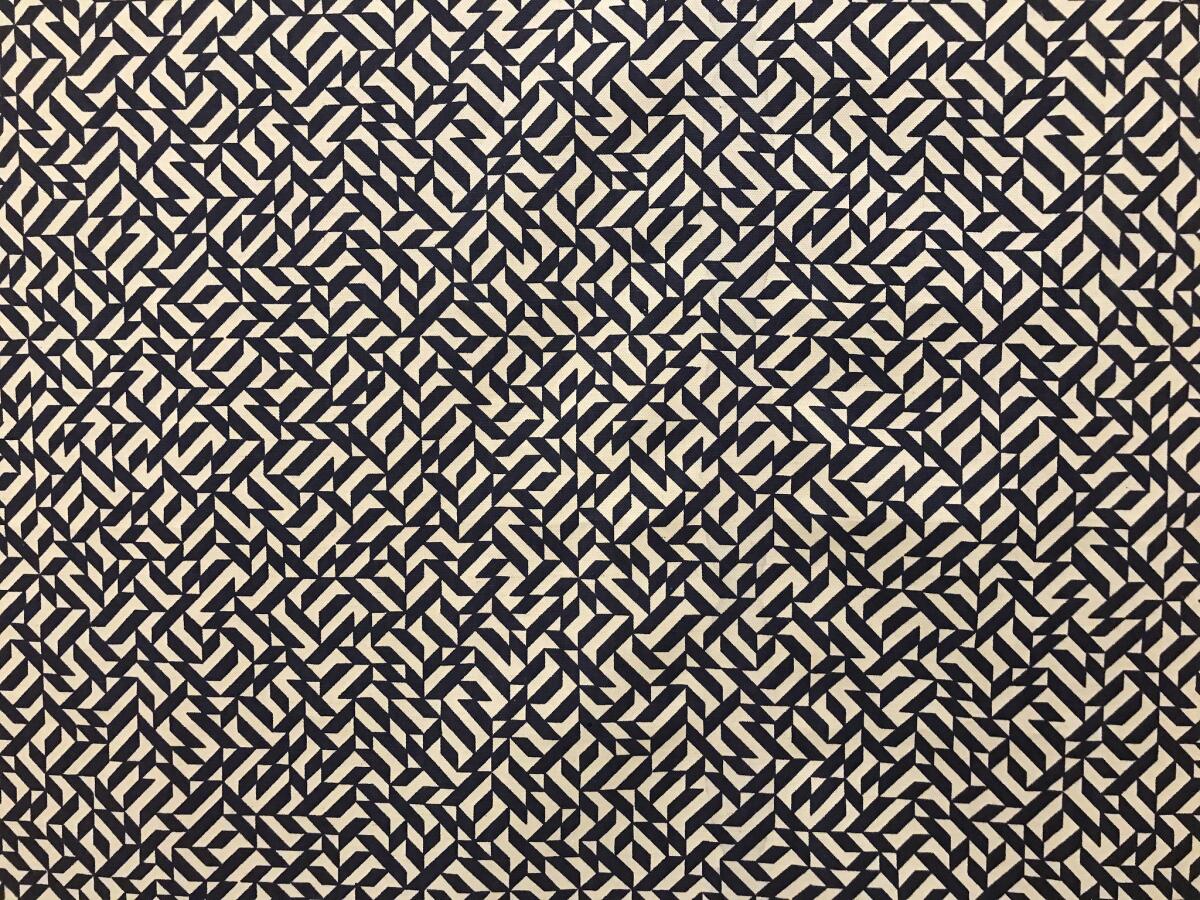How a constellation of 6 artists — all women — helped make Modernism more Mexican
- Share via
Chicago — The reputation of late Mexico City designer Clara Porset has, for a long time, rested, quite literally, on a chair.
Namely, her sleek, Modernist interpretations of the butaque chair, known as a butaca in Spanish, a casual, low-slung lounger, often upholstered in leather, that has been a Mexican craft staple since at least the Spanish colonial era. (The design is thought to have both Spanish and indigenous roots.)
In the 1940s and ‘50s, Porset’s chairs appeared in homes designed by prominent architects such as Luis Barragán and in the pages of international design magazines. A 1952 article about her work in The Times shows her butaques under the headline “You’ll sit low in Mexico!” Around that same time, Los Angeles architecture writer Esther McCoy tried to mass produce the chairs for the U.S. market. (The plan never got off the ground.)
Today, Porset’s furnishings are treated like fetish objects, with online design shops touting chairs “in the style of Clara Porset” and her surviving pieces fetching thousands of dollars online.
But the designer’s legacy goes way beyond chairs.
Porset, who was born in Cuba in 1895 and lived most of her life in Mexico, was a catalyst: a curator, writer and activist who sparked connections between artists and served as a nexus through which ideas were assembled and disseminated. And she is at the heart of an ongoing exhibition at the Art Institute of Chicago that looks at the ways in which six Modern artists — all women — were engaging Mexican art and crafts in the middle of the 20th century.
“In a Cloud, in a Wall, in a Chair: Six Modernists in Mexico at Midcentury,” as the show is titled, brings together work by Porset in dialogue with five artists living in the U.S. and Mexico. These were figures who blurred the line between art and design and between craft and industrial production and who, in the process, helped make international Modernism more Mexican.
This includes Mexican photographer Lola Álvarez Bravo, known for her elegant portraiture and dynamic photomurals; U.S. sculptor Ruth Asawa, whose amoebic woven wire sculptures were inspired by basketry techniques from Toluca; as well as a trio of avant-garde textile artists — Sheila Hicks, Cynthia Sargent and Anni Albers (the latter of Bauhaus fame) — whose brilliant designs all bore the imprint of Mexican motifs and weaving techniques.
Porset was linked, by varying degrees, to all these figures.
“She was the preeminent Modern designer,” says exhibit curator Zoë Ryan. “Her network was vast. She was an international figure herself. She was so singular in advocating for a culture of design and was a prolific writer and curator.”
“In a Cloud” is not a comprehensive study of craft and Modernism in Mexico at midcentury. Instead, the show (and its accessible, worthwhile catalog) provides a broad overview of Porset’s work in relation to the other artists on view and their work in relation to one another. More significant, it fills some narrative gaps in the history of Modernism, which skews male, shining a light on the lively exchange of ideas within a network of women artists.
“I felt like there was a hole in the design knowledge,” says Ryan, who also chairs the Art Institute’s department of architecture and design. Porset, in particular, left behind “a big body of work, and very little of that work was known — even in Mexico.”
The show zeroes in on a key moment in Mexican history: the decades around World War II when the country was attracting artists from all over the world and Mexican art was materializing in high-profile institutions in the U.S. (including the sprawling “Twenty Centuries of Mexican Art,” which opened to much fanfare at New York’s Museum of Modern Art in 1940).
“It’s this post-revolutionary period in Mexico,” Ryan says. “It’s a time of social and cultural change. It was like Paris. All of the intellectuals were there.”
Among them was Porset, who had ended up in Mexico City in 1935, after her left-wing political activities made it difficult for her to remain in Cuba.
I felt like there was a hole in the design knowledge.
— Zoë Ryan, curator
In Mexico, she married Xavier Guerrero (1896-1974), a pioneering indigenous muralist who was part of a wave of artists that sought to present a view of Mexico rooted in folk tradition and indigeneity. He was not alone: The early 20th century had given rise to indigenist cultural movements across Latin America. And in the wake of the Mexican Revolution, intellectuals were actively looking for ways to build a national identity that didn’t rest on a rehash of European ideas.
This milieu influenced Porset, who proceeded to create furnishings that embraced both Mexican craft traditions and International Style Modernism, resulting in pieces she described as “our own kind of furniture.”

“She’s looking at the Bauhaus and the Museum of Modern Art,” says Ryan. “But she’s trying to think about that within the context of Mexico. ... You see these amazing drawings where you see her furniture in a Mexican garden with a Bertoia chair. She’s saying, ‘We’re just as Modern. But this is our own kind of furniture born out of our context.’”
In addition to various butaque designs (including one for kids), the Art Institute’s exhibition features Porset’s Totonac chair, inspired by a type of seat depicted in 5th century Mesoamerican ceramics — a regal Modernist throne.
Porset’s quest for a uniquely Mexican style of design, however, wasn’t limited to her own work.
The designer wrote for a variety of international publications (including The Times) and curated the influential design exhibition “Art in Daily Life: Well-Designed Objects Made in Mexico,” which opened in Mexico City in 1952. The show displayed handmade crafts and industrial objects — say, wooden chocolate pots from the Yucatán alongside a refrigerator by DM Nacional — to show the breadth of Mexican production.
“It is important to infuse industry — that is, the machine — with the extraordinary sensitivity of the Mexican, who over the millennia, has created so many and such a variety of beautiful forms using manual techniques,” wrote Porset of the concept.
This interest in artisanry is what links her, directly and indirectly, to the five other artists in the Art Institute’s show.
Porset, for example, had a professional connection to Sargent.
In “Art in Daily Life,” she had displayed textiles designed by Sargent, a U.S. artist who, with her husband, Wendell Riggs, had established a craft studio in Mexico in 1951. There the pair produced printed fabrics and rugs that fused Modern design with traditional Mexican color palettes and weaving techniques (evident in a piece titled “Bartok,” a rug of brilliant ruby reds that hangs in the Art Institute’s installation).
The inclusion in Porset’s show helped fuel Sargent’s success and, in turn, helped support Mexican craftmaking. Like, Porset, Sargent and Riggs were important advocates for craft, staging artisan exhibitions in their studio and helping establish a Saturday craft market in Mexico City (El Bazaar Sábado) that continues to this day.
Following “Art in Daily Life,” the couple collaborated with Porset on other projects, including upholstery design on her Totonac chair.

Porset likewise had close connections to another linchpin figure in the global universe of art and craft: Albers, the German-born textile artist who had ended up teaching at the experimental Black Mountain College in North Carolina after the Nazis came to power in Germany. Porset had guided Albers and her husband, painter Josef Albers, around Mexico when they visited for the first time in the 1930s, introducing them to artists and thinkers. And the couple returned 13 more times over the next three decades, trips that proved formative.
“In a Cloud” displays drawings and textiles by Anni that bear the influence of the stark, geometric designs she was seeing at ancient archeological sites such as Monte Albán. It features whimsical objects, too: one vitrine contains jewelry Albers made in collaboration with Alexander Reed that transformed ordinary household hardware — strainers, paper clips, bobby pins — into objects that evoke ancient adornments.
In this manner, “In a Cloud” charts Porset’s other connections too.
There are photomontages by Álvarez Bravo, a close friend of Porset’s who often photographed the designer’s furniture for publication. Her large-scale photo murals — painstakingly composed of fragments of hand-cut photos and blown up to mural size in the days before Photoshop — show Mexican cityscapes and monuments cobbled together in ways that nod to the dramatic compositional language of muralism. These are staggered throughout the show and give the works of craft a Modern, urban edge.
One gallery bears an array of organic wire forms woven by Asawa, a Japanese American artist from California who spent time in Mexico after World War II. It turns out it was Porset who encouraged the young artist to consider enrolling at Black Mountain College, where the Albers were teaching — a decision that would shape the rest of Asawa’s career.
The Albers are also connected with another artist in the show: Hicks, an experimental 20th century textile artist who helped turn weaving into a sculptural act. She studied under the Alberses at Yale (where they landed after Black Mountain). Hicks too developed a profound connection with Mexico, counting Barragán, a close associate of Porset’s, among her mentors.
Collectively, the show speaks to the ways in which Mexican craft has infused international design. (To see the effect, all you have to do is travel one floor down, to the Art Institute’s textile galleries, and check out the separate exhibition, “Weaving Beyond the Bauhaus,” which charts the influence of Bauhaus figures such as Anni Albers on subsequent generations of textile artists. The show, which also features work by Hicks, captures some of those later Mexican influences.)
Most significant, however, “In a Cloud” charts the ways in which art movements truly work. Not some lone genius alone in a studio or expounding in a cafe. Instead, constellations of artists who embrace myriad traditions, all intersecting in a time and a place, drawn together by their curiosity and the curiosity of others. Artists who, in some cases, just happen to be women. And at their center another artist who functioned as spark and connector — a woman full of ideas who also happened to create some very beautiful chairs.
"In a Cloud, in a Wall, in a Chair: Six Modernists at Midcentury"
More to Read
The biggest entertainment stories
Get our big stories about Hollywood, film, television, music, arts, culture and more right in your inbox as soon as they publish.
You may occasionally receive promotional content from the Los Angeles Times.











